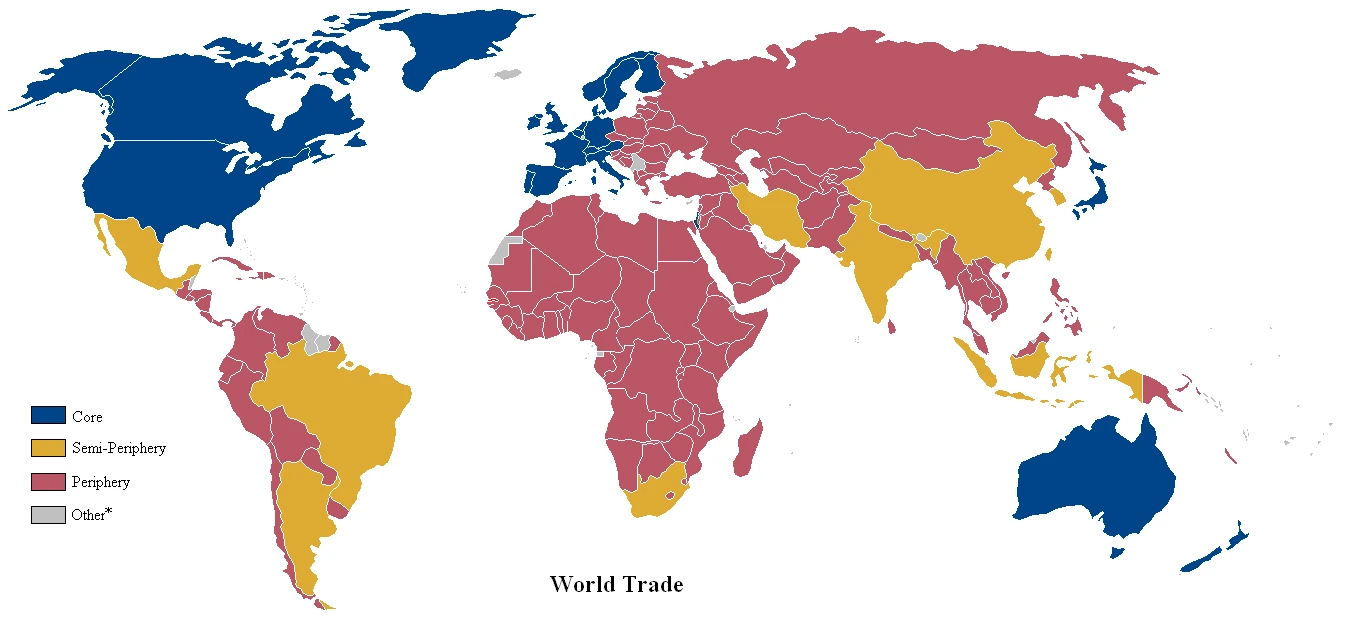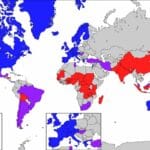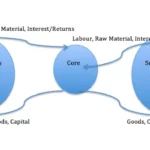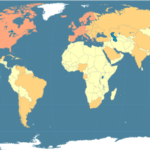Are you ready to take a deep dive into the thought-provoking realm of global inequality? This exploration of World System Theory will guide you through the intricate ways this theory explains the patterns of inequality, power dynamics, and historical influences shaping our globalized world. Let’s unravel the complexities of our interconnected planet together!
World System Theory: A Framework for Understanding Global Inequality
Ever wonder why some countries seem to prosper while others struggle? World System Theory attempts to explain this disparity. Rather than viewing countries as isolated entities, this theory suggests that the entire world operates as a single, interconnected system—a global web of economic relationships where some parts inevitably benefit more than others.
Imagine the world as a team project. There are the leaders, the workers, and those who participate passively. In this global project, the leaders are typically the wealthy, industrialized nations, often dictating the terms of global trade and setting international rules. Developing countries, often supplying raw materials and cheap labor, take on the role of the workers. Unfortunately, these countries often don’t receive a fair share of the profits.
Immanuel Wallerstein, a key figure in developing this theory, traced this global power imbalance back to the rise of capitalism in 16th-century Europe. As Europe embarked on a period of colonization, extracting resources from newly discovered lands, they laid the foundation for their own wealth and power, a legacy that continues to echo through the global economy today.
World System Theory encourages us to look beyond individual nations and grasp the bigger picture. It underscores that events in one part of the world can create ripples felt globally. While this system is complex, understanding it offers a new lens through which to view global inequality and the challenges we collectively face.
What is the World Systems Theory?
World Systems Theory proposes that the world functions as a singular, interconnected system, much like an intricate machine with interdependent parts. This system, however, is not one of equals. Instead, a hierarchy emerges, with “core” countries wielding significant power and wealth. These dominant players often set the agenda in global trade and politics.
On the other end of the spectrum are “peripheral” countries, often still developing and facing substantial economic hurdles. According to World Systems Theory, core countries may perpetuate this imbalance, benefiting at the expense of peripheral nations through practices like exploitative trade deals or resource extraction.
Bridging the gap between these two are the “semi-peripheral” countries. These nations exhibit characteristics of both core and peripheral countries, perhaps experiencing economic growth but not yet reaching the dominance of the core.
The theory challenges the notion of countries as entirely independent entities, suggesting that a nation’s position within the world system—whether core, periphery, or semi-periphery—significantly shapes its trajectory, influencing its economic prospects and international relations.
Key Takeaways:
- Interconnectedness: Actions within the global system have far-reaching consequences.
- Global Economics: Economic processes on a global scale drive social change and inequality.
- Core-Periphery Dynamic: An imbalance of power exists between core and peripheral countries.
- Beyond Individual Nations: The global system influences the actions and development of nations.
Citation:
Wallerstein, Immanuel. “World-Systems Analysis: An Introduction.” Duke University Press, 2004.
What Does World System Theory Believe?
World System Theory posits that the global economic system operates like a high-stakes game where some countries hold a distinct advantage from the outset. The “core” countries, often the wealthiest nations with substantial political influence, essentially control the rules of the game, shaping the global economy to their benefit.
In contrast, “peripheral” countries, often located in Africa, Latin America, or parts of Asia, find themselves struggling to keep pace. They frequently supply raw materials and low-cost labor that fuel the core countries’ economies. This disparity, according to the theory, is not accidental. The structure of the global economy perpetuates this imbalance, favoring the core at the expense of the periphery.
The historical context of colonialism plays a significant role in this theory. As European powers expanded their reach, claiming land and resources, they laid the groundwork for the current world system. Those early colonizers became the core, while the colonized regions became the periphery.
World System Theory argues that these patterns of dominance persist, albeit in different forms. Unequal trade agreements, the influence of multinational corporations, and debt burdens maintain the dependence of peripheral countries on the core.
While not without its critics, World System Theory offers a valuable framework for understanding global inequality. It challenges us to see the interconnectedness of nations within a single system and question how this system creates winners and losers.
What is the Theory of the Global System?
World Systems Theory provides a framework for understanding the interconnectedness of the world by viewing the entire planet as one integrated system. This system, however, is characterized by an uneven distribution of power and wealth.
“Core” countries, often those with advanced economies and significant political influence, tend to benefit most from the current structure of the global economy. Conversely, “peripheral” countries often provide resources and labor to the core but struggle to reap the full benefits of their contributions.
It’s crucial to recognize that this theory is a model, a way of making sense of complex global interactions. While the core-periphery dynamic is central to this theory, the real world is more nuanced. Some countries may occupy a middle ground (“semi-periphery”), and the system itself is not static.
However, World Systems Theory suggests that the way the global system operates often reinforces these power imbalances. For example, global trade rules or the influence of powerful nations on international institutions can sometimes hinder the economic advancement of peripheral countries.
Understanding World Systems Theory is essential for grasping the complexities of global inequality, the effects of globalization, and the challenges faced by developing countries. It reminds us that we are all part of a complex, interconnected web where our actions have global repercussions.
What is the Difference Between World Systems Theory and Dependency Theory?
Both dependency theory and world systems theory challenge the notion that underdeveloped countries can simply “catch up” to developed nations. They both contend that the global economic system is inherently unequal, favoring some countries at the expense of others. However, they differ in their scope and emphasis.
Dependency Theory: This theory zeroes in on the relationship between a more powerful country, often a former colonial power, and a less powerful one. It suggests that developed, “core” countries actively maintain the economic dependence of developing, “periphery” countries through mechanisms like imbalanced trade agreements or control over essential resources and technology.
World Systems Theory: This theory takes a broader perspective, viewing the entire world as a single, interconnected capitalist system with a clear hierarchy. Core countries occupy the top tier, controlling wealth and resources, while peripheral countries provide cheap labor and resources. Semi-peripheral countries fall somewhere in between.
Here’s a table summarizing the key differences:
| Feature | Dependency Theory | World Systems Theory |
|---|---|---|
| Focus | External forces, power relations | Global economic hierarchy |
| Scope | Individual country relationships | Global system as a whole |
| Emphasis | Exploitation, dependence | Interdependence, hierarchical relations |
Both theories have limitations. Dependency theory is sometimes criticized for being overly simplistic and neglecting internal factors within developing countries. World Systems Theory, while comprehensive, can sometimes overlook the unique circumstances of individual nations.
Despite these limitations, both dependency theory and world systems theory offer crucial lenses for analyzing global inequality, reminding us to consider the historical and economic forces shaping our world.
Is Indonesia a Periphery Country?
Classifying countries within the world system can be complex. Periphery countries, often characterized by weak governance, economic dependence, and vulnerability to exploitation, occupy a challenging position within the global hierarchy. But where does a nation like Indonesia, with its unique mix of economic progress and ongoing challenges, fit in?
Some argue that Indonesia exhibits classic characteristics of a periphery country. Its dependence on raw material exports, weak labor protections, and a lack of advanced technology all point in this direction. However, Indonesia’s recent economic growth, growing manufacturing sector, increasing urbanization, and relatively stable government suggest a potential trajectory toward semi-periphery status.
One crucial factor to consider is that even when manufacturing shifts to periphery countries, companies from core nations often retain significant control. This dynamic makes it challenging for periphery countries to achieve genuine economic independence and ascend the world system ladder.
Ultimately, Indonesia’s position within the world system remains a matter of debate. Its future classification will depend on its ability to address internal challenges, enhance its global competitiveness, and deftly navigate the complexities of international relations.
What is the World Systems Theory of Marxism?
World Systems Theory (WST), with roots in Marxist thought, views the global economy as an interconnected network characterized by inherent inequality. This theory argues that the global system resembles a pyramid, with “core” countries—wealthy, industrialized nations with significant political power—occupying the top tier. These core countries establish the rules of the game to their advantage.
At the bottom of this pyramid are “peripheral” countries, often developing nations striving for economic progress. These countries often supply raw materials and cheap labor to the core but lack comparable economic and political power. “Semi-peripheral” countries, caught in the middle, may be experiencing growth but haven’t yet attained the dominance of core nations.
WST posits that core countries actively maintain their dominance through various means, including:
- Unequal trade deals that favor the core
- Control over technology and its dissemination
- Military intervention, when deemed necessary
This dynamic allows core countries to prosper while peripheral nations struggle to break free from a cycle of dependence.
It is important to acknowledge that WST is not without criticism. Some argue that it oversimplifies global complexities or overemphasizes economic factors while downplaying the role of culture and internal politics.
However, even with its limitations, WST offers a valuable framework for understanding global inequality and the obstacles confronting developing countries. It underscores the lasting impact of historical patterns of colonialism and imperialism on the present-day world.
Key Takeaways:
- WST perceives the global economy as a hierarchy.
- This power dynamic can lead to exploitation of the periphery.
- Core countries use various mechanisms to maintain their dominant position.
- WST helps explain global inequality and the challenges faced by developing nations.
- The theory highlights the interconnectedness of the global economy.
Citation:
- Wallerstein, I. (1979). The capitalist world-economy: Essays. Cambridge University Press.
What is the Concept of System Theory?
World System Theory, like piecing together a giant puzzle, suggests that everything in the global system is interconnected. However, this interconnectedness is characterized by inequality, where some countries hold more power and resources than others. This theory examines how global economic forces contribute to a division between “haves” (core countries) and “have-nots” (periphery countries).
The historical legacy of colonialism plays a significant role in this theory. The expansion of European powers and their exploitation of resources and labor in other parts of the world established patterns of dominance that continue to influence the global economy today. While globalization has brought about changes, the fundamental concept of some countries holding more sway in the global arena remains relevant.
Critics of this theory rightly point out that reducing global dynamics solely to economics is an oversimplification. Factors such as culture, politics, and technology also contribute to the complexities of the world system. Additionally, focusing solely on historical trends may not fully encompass the nuances of contemporary global issues.
Despite its limitations, World System Theory offers a valuable framework for understanding the intricate web of global forces shaping our lives. It reminds us to look beyond individual nations and consider the interconnectedness of global systems, potentially paving the way for a more just and equitable world.
For further exploration, the work of sociologist Immanuel Wallerstein, particularly his book “World-systems analysis: An introduction,” provides a comprehensive understanding of this theory.
What is the Systems Theory Worldview?
World-systems theory (WST) proposes that the world operates as a vast, interconnected system, much like a spiderweb where each strand represents economic, political, and cultural ties. This interconnectedness implies that events in one part of the world can have far-reaching consequences, influencing the destinies of nations across the globe.
Instead of analyzing individual countries in isolation, WST emphasizes understanding their position and relationships within this larger web. Developed by scholar Immanuel Wallerstein in the 1970s, WST has been used to explain the rise of capitalism, the evolution of the modern world, and the persistence of global inequality.
One of WST’s central tenets is the “core-periphery” model. This model divides the world into three tiers:
- Core Countries: Industrialized nations with strong economies, advanced technology, and political power.
- Peripheral Countries: Nations often grappling with poverty, underdeveloped industries, and political instability.
- Semi-Peripheral Countries: Occupying a middle ground, these countries exhibit characteristics of both core and peripheral nations.
It’s crucial to recognize that WST is a theoretical framework, not a crystal ball. Critics argue that it overemphasizes economic factors and simplifies complex realities into somewhat rigid categories.
However, despite its limitations, WST offers a valuable lens for understanding global dynamics. It underscores the interconnectedness of our world and reminds us that global challenges require collective solutions.
Key Takeaways:
- WST encourages a holistic view of the world as an interconnected system.
- Understanding a country’s position within the global system is paramount.
- The core-periphery model highlights the economic and power imbalances between nations.
- While not without its critics, WST provides a valuable perspective on global dynamics.
Citation:
Wallerstein, Immanuel. “The Modern World-System: Capitalist Agriculture and the Origins of the European World-Economy in the Sixteenth Century.” Academic Press, 2011.
What is the Main Focus of World-Systems Analysis?
World-systems analysis encourages us to shift our perspective from individual nations to the interconnected global system. This approach recognizes that the economies of countries are intricately woven together, creating a complex web of relationships and power dynamics.
Central to this analysis is the concept of a hierarchical “world-system,” where some countries hold significantly more power and wealth than others. This hierarchy is often depicted as a pyramid, with “core” countries—typically the most developed and industrialized nations—at the top, dictating the terms of global trade and economic interactions.
At the base of the pyramid are “peripheral” countries, often still developing and possessing fewer resources and less global influence. These countries frequently supply raw materials or cheaper labor to core nations. In between are “semi-peripheral” countries, striving to ascend the economic ladder.
World-systems analysis argues that this core-periphery relationship is not random but rooted in historical events like colonialism. The exploitation of resources and labor during this period continues to shape global inequality today.
Here’s a table summarizing the key features of each category:
| Category | Characteristics | Examples |
|---|---|---|
| Core | Dominant in the global economy, industrialized, wealthy | USA, Japan, Germany |
| Periphery | Less developed, often resource-dependent | Many countries in Africa, parts of Southeast Asia |
| Semi-periphery | In-between, experiencing industrialization but not dominant | Brazil, Mexico, China (debated) |
It is important to acknowledge that the world is not static, and countries can transition between these categories. Additionally, world-systems analysis has its critics, with some arguing that it oversimplifies global complexities.
However, this approach provides a valuable framework for understanding global inequality, prompting us to consider the historical and economic forces shaping our world and the interconnectedness of global events.
What are the Three Categories of the World-Systems Theory?
World Systems Theory, developed by sociologist Immanuel Wallerstein, categorizes countries within the global economy into three main groups: core, periphery, and semi-periphery. This classification helps explain the distribution of power and wealth on a global scale.
Core Countries: These countries represent the major players in the global economy. They are typically characterized by:
- Advanced Economies: High levels of industrialization and technological development.
- Political Influence: Significant power in shaping global affairs and international institutions.
- Control over Resources: Often control the flow of capital, technology, and resources.
Peripheral Countries: These countries are often less developed and occupy a more vulnerable position in the global economy. They are characterized by:
- Dependence on Exports: Rely heavily on exporting raw materials to core countries.
- Lower Wages and Labor Standards: Often provide cheap labor for multinational corporations.
- Vulnerability to Exploitation: Susceptible to unfair trade practices and exploitation by core countries.
Semi-Peripheral Countries: Occupying a middle ground, these countries exhibit characteristics of both core and periphery countries. They are often:
- Industrializing: Experiencing economic growth and industrial development, but not yet at the level of core countries.
- Seeking Advancement: Attempting to move up the global economic ladder.
- Playing a Dual Role: May both benefit from and be exploited by core countries.
It is essential to remember that this model is a simplification of a complex reality. The lines between these categories can be fluid, and countries can transition between them over time. Additionally, factors beyond economics, such as internal politics and social structures, also play a role in shaping a country’s position within the world system.
Despite its limitations, World Systems Theory offers a valuable framework for understanding global inequality and the power dynamics at play on the world stage. It encourages us to look beyond national borders and consider the interconnectedness of nations within a global web of economic relationships.
Key Takeaways:
- Core Countries: Dominant players in the global economy, possessing advanced economies and political influence.
- Peripheral Countries: Often reliant on exporting raw materials and vulnerable to exploitation by core countries.
- Semi-Periphery Countries: Occupy a middle ground, sharing characteristics of both core and peripheral countries.
Citation:
Wallerstein, I. (2004). World-systems analysis: An introduction. Duke University Press.
By exploring concepts like World Systems Theory, we can gain a deeper understanding of the forces shaping our world and work towards a more just and equitable future for all. Don’t stop here! Continue exploring these ideas by checking out the following resources:
- Uncover the complexities of global economic and social structures by exploring the World Systems Theory.
- Delve into the intricate dynamics of the Semi Periphery and its pivotal role in the interconnectedness of the world system.
- Engage in a critical analysis of the Criticisms of Wallerstein’s World System Theory, scrutinizing its assumptions and limitations.
- Discover when was glass first made: Ancient origins & global impact - March 28, 2025
- Unlocking It’s Greek to Me: A History and Meaning - March 28, 2025
- Ancient Greece Clothing Styles: A Complete History - March 28, 2025

















2 thoughts on “Unraveling Global Inequality: A Deep Dive into World System Theory”
Comments are closed.